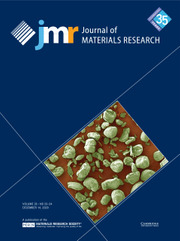Article contents
Entrapment of organosilicon molecules in nonhydrolytic alumina gels and thermal behavior of the resulting composite
Published online by Cambridge University Press: 31 January 2011
Abstract
This work describes the entrapment of tetrakis(trimethylsilyl)silane (TK) and tetrakis(chlorodimethylsilyl)silane (TKCl) in nonhydrolytic alumina gels, and the materials' thermal behavior. During gelation and drying TK and TKCl are physically entrapped in the gel up to a limit of Si/Al = 0.33. Above this limit, sublimation and decomposition of TK and TKCl occur during heating. A larger fraction of TKCl decomposition products is retained due to their higher reactivity. Below and above Si/Al = 0.33, the gel converts to mullite + α−Al2O3or mullite + amorphous silica, respectively. Conversion to hexagonal mullite indicates atomic scale homogeneity of Si and Al during firing.
Information
- Type
- Articles
- Information
- Copyright
- Copyright © Materials Research Society 2001
References
REFERENCES
- 1
- Cited by

